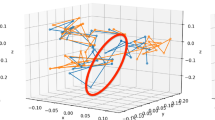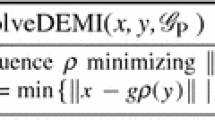Abstract
An important component of computer programs for determining the solution conformation of proteins and other flexible molecules from nuclear magnetic resonance data are the so-called “bound smoothing algorithms”, which compute lower and upper limits on the values of all the interatomic distances from the relatively sparse set which can usually be measured experimentally. To date, the only methods efficient enough for use in large problems take account of only the triangle inequality, but an appreciable improvement in the precision of the limits is possible if the algebraic relations between the distances among each quadruple of atoms are also considered. The goal of this paper is to use a recently improved algorithm for computing these “tetrangle inequality limits” to determine just how much improvement really is possible, given the types of experimental data that are usually available.
Similar content being viewed by others
Literature
Billeter, M., W. Braun and K. Wüthrich. 1982. “Sequential Resonance Assignments in Protein1H Nuclear Magnetic Resonance Spectra.”J. Molec. Biol. 155, 321–346.
Blumenthal, L. M. 1970.Theory and Applications of Distance Geometry. New York: Chelsea.
Braun, W. 1987. “Distance Geometry and Related Methods for Protein Structure Determination from NMR Data.”Quart. Rev. Biophys. 19, 115–157.
Crippen, G. M. and T. F. Havel. 1988.Distance Geometry and Molecular Conformation. Chemometrics Research Studies Press in press.
Dress, A. W. M. and T. F. Havel. 1988. “Shortest Path Problems and Molecular Conformation.”Discrete Appl. Math. 19, 129–144.
Havel, T. F., I. D. Kuntz and G. M. Crippen. 1983. “The Theory and Practice of Distance Geometry.”Bull. Math. Biol. 45, 665–720.
— and K. Wüthrich. 1984. “A Distance Geometry Program for Determining the Structures of Small Proteins and other Macromolecules from Nuclear Magnetic Resonance Measurements of1H−1H Proximities in Solution.”Bull. Math. Biol. 46, 281–294.
Kabsch, W. and C. Sander. 1983. “Dictionary of Protein Structure: Pattern Recognition by Hydrogen-bonded and Geometrical Features.”Biopolymers 22, 2577–2637.
Wüthrich, K., M. Billeter and W. Braun. 1983. “Pseudostructures for the 20 Common Amino Acids for Use in Studies of Protein Conformations by Measurements of Intramolecular Proton-Proton Distance Constraints with Nuclear Magnetic Resonance”.J. Molec. Biol. 169, 949–961.
— 1986.NMR of Proteins and Nucleic Acids. New York: Wiley.
Author information
Authors and Affiliations
Rights and permissions
About this article
Cite this article
Easthope, P.L., Havel, T.F. Computational experience with an algorithm for tetrangle inequality bound smoothing. Bltn Mathcal Biology 51, 173–194 (1989). https://doi.org/10.1007/BF02458843
Received:
Issue Date:
DOI: https://doi.org/10.1007/BF02458843




